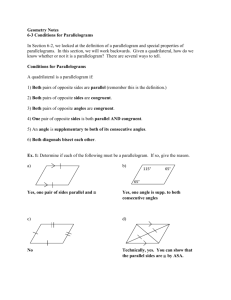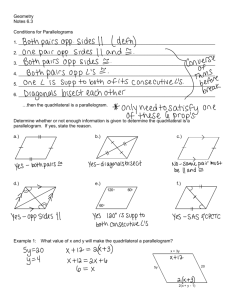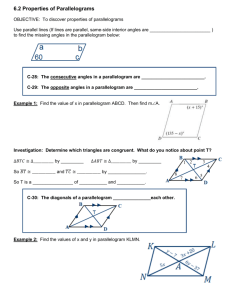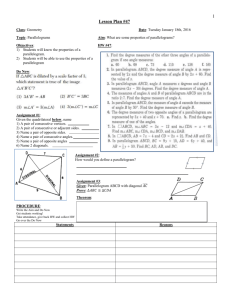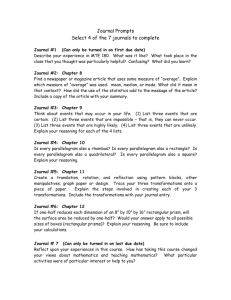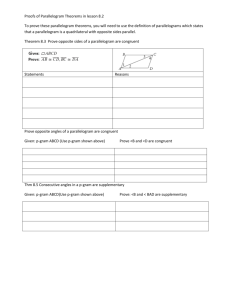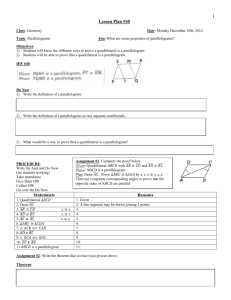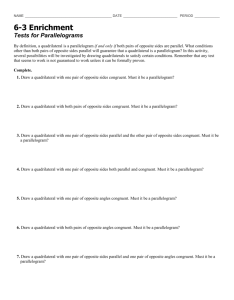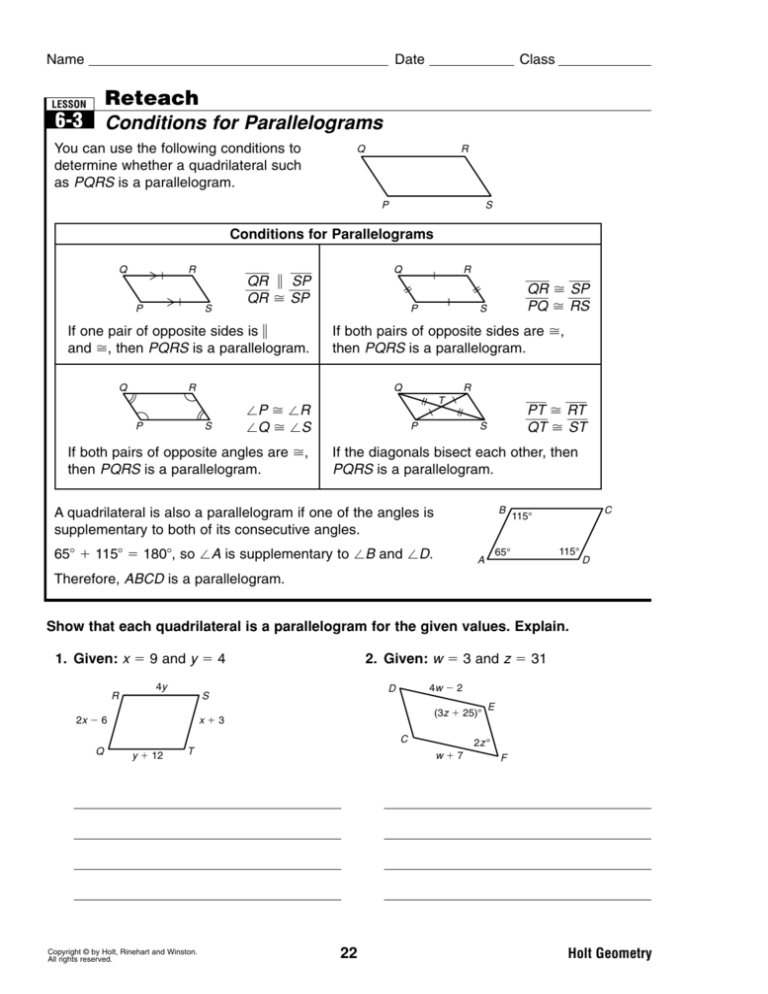
Name
Date
Class
Reteach
LESSON
6-3
Conditions for Parallelograms
You can use the following conditions to
determine whether a quadrilateral such
as PQRS is a parallelogram.
1
2
0
3
Conditions for Parallelograms
1
_
2
0
3
_
If one pair of opposite sides is and , then PQRS is a parallelogram.
1
1
QR
SP
_ _
QR SP
0
3
1
3
2
_
4
⬔P ⬔R
⬔Q ⬔S
If both pairs of opposite angles are ,
then PQRS is a parallelogram.
_
_
QR
SP
_ _
PQ RS
If both pairs of opposite sides are ,
then PQRS is a parallelogram.
2
0
2
0
_
PT
_ RT
_
QT ST
3
If the diagonals bisect each other, then
PQRS is a parallelogram.
"
A quadrilateral is also a parallelogram if one of the angles is
supplementary to both of its consecutive angles.
65⬚ ⫹ 115⬚ ⫽ 180⬚, so ⬔A is supplementary to ⬔B and ⬔D.
#
!
$
Therefore, ABCD is a parallelogram.
Show that each quadrilateral is a parallelogram for the given values. Explain.
1. Given: x ⫽ 9 and y ⫽ 4
2
Y
2. Given: w ⫽ 3 and z ⫽ 31
X
W
$
3
Z
X
#
1
Y
4
%
Z
W
&
QR ⫽ ST ⫽ 12; RS ⫽ TQ ⫽ 16;
DE ⫽ FC ⫽ 10; m⬔E ⫽ 118⬚
both pairs of opp. sides are ⬵.
and m⬔F ⫽ 62⬚, so ⬔E and ⬔F
_
_
are supp. and DE 储 FC ; one pair
of opposite sides are 储 and ⬵.
Copyright © by Holt, Rinehart and Winston.
All rights reserved.
22
Holt Geometry
Name
Date
LESSON
6-3
Class
Reteach
Conditions for Parallelograms
continued
You can show that a quadrilateral is a parallelogram by using any of the conditions
listed below.
Conditions for Parallelograms
• Both pairs of opposite sides are parallel (definition).
• One pair of opposite sides is parallel and congruent.
• Both pairs of opposite sides are congruent.
• Both pairs of opposite angles are congruent.
• The diagonals bisect each other.
• One angle is supplementary to both its consecutive angles.
&
%
+
'
,
(
*
EFGH must be a parallelogram
because both pairs of opposite
sides are congruent.
-
JKLM may not be a parallelogram
because none of the sets of conditions
for a parallelogram is met.
Determine whether each quadrilateral must be a parallelogram.
Justify your answer.
3.
4.
Yes; one pair of opp. sides is 储
Yes; the diagonals bisect each
and ⬵.
other.
5.
6.
Yes; both pairs of opp. ⭄ are ⬵.
No; none of the sets of conditions
for a parallelogram is met.
Show that the quadrilateral with the given vertices is a parallelogram by
using the given definition or theorem.
7. J (⫺2, ⫺2), K(⫺3, 3), L(1, 5), M(2, 0)
Both pairs of opposite sides are parallel.
_
8. N(5, 1), P(2, 7), Q(6, 9), R (9, 3)
Both pairs of opposite sides are
congruent.
_
slope of JK ⫽ slope of LM ⫽ ⫺5;
_
_
1
slope of KL ⫽ slope of MJ ⫽ __
2
Copyright © by Holt, Rinehart and Winston.
All rights reserved.
23
NP ⫽ QR ⫽ 35 ;
PQ ⫽RN ⫽ 25
Holt Geometry

